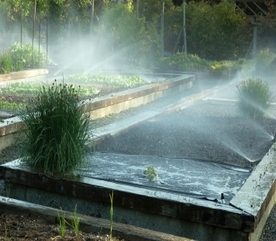Building Raised Beds to Maximize Your Landscape
A raised bed can do wonders for maximizing your landscape araea. Virtually all plants other than large trees are suitable for growing in a raised bed. Even substantial shrubs can thrive, provided the bed is large and high enough. The higher the bed, the more suitable it will be for plants with an extensive root system.

A raised bed is also useful for growing certain types of plant that will not tolerate your garden soil. For example, alpines need a very well-drained, open, gritty medium and would soon rot in waterlogged or very heavy earth. But if you have clay soil, you can still make an attractive collection of alpines in a well-drained raised bed filled with free-draining compost.
Raised Beds: A Permanent Design Feature
Deisgn. As part of a garden design, raised beds provide an opportunity to introduce attractive hard landscaping materials, such as brick or stone, log-roll edging, railway sleepers or other timber. The beds can be finished off with ornamental mulches such as coloured chippings or gravel and decorative bark.
Shape. The shape of the bed can be whatever suits the situation best. Rectangular, circular, oval or non-geometric beds are all possible as long as the height remains in proportion to the length and breadth. A tall raised bed of otherwise modest proportions would look odd in most gardens.
Free-Standing vs. Wall Support. A raised bed can be either free-standing or built against a solid, vertical surface. Generally, raised beds against house walls are not a good idea, unless sufficient damp-proofing protection is provided between the bed and the wall. Otherwise the wall’s damp-proofing course will be breached and the wall damaged. If the bed is against a wooden fence, there should be a waterproof barrier between the timber and the compost to protect the fence.
The walls of the raised bed need some kind of foundation, otherwise the pressure of the compost on the sides will eventually cause the bed to collapse. In the case of brick or stone, a foundation of waterproof bricks (such as engineering bricks) or blocks is suitable.
Sink railway sleepers into the ground to about half their depth. Treat log-roll edging in the same way, although deep edging should be sunk slightly deeper than halfway, to prevent it being pushed out of shape.
Timber will gradually weather and rot, but such deterioration can be reduced by impregnating wood with a horticultural preservative. Railway sleepers are already treated against rot, and log-roll edging is usually pressure-treated for a guaranteed 10 years. All untreated timber should be soaked in a spirit-based preservative and allowed to dry before you start on the construction of the bed.
Good Drainage Is The Key
Adequate drainage is essential for a raised bed. For brick or stone beds, leave vertical joints without mortar at intervals in the first course above ground level. For timber walls, drill 2.5cm (1in) holes, 30cm (1ft) apart and 15cm (6in) above the ground. It is also a good idea to cover the base with a layer of hardcore before adding the compost or soil.



